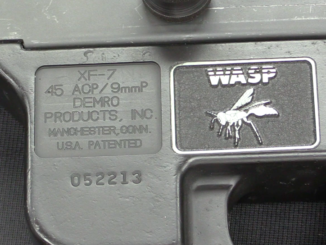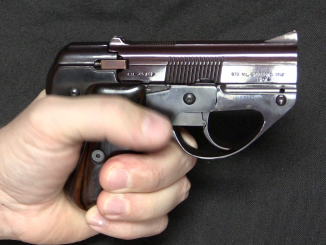The Springfield Arms Company existed only for a brief period in 1850 and 1851, making revolvers designed by its chief engineer, James Warner, before being driven out of business by Colt patent lawyers. During that time, Springfield (no relation to the arsenal) made a variety of models in .28, .31, and .36 caliber and with a variety of barrel lengths and other features (including a well-designed safety notch to allow the guns to be carried fully loaded safely). In an attempt to avoid patent infringement, Warner separated the cylinder rotation and firing mechanisms into two different triggers on some models, including this Navy pattern example. The front trigger would rotate and lock the cylinder, and then it would trip the rear trigger which released the sear and fired the gun. This was not sufficient to save him from copyright infringement suits, though, and only about 125 of the double-trigger Navy revolvers were made.




This is overly complicated and user-unfriendly. I suspect that the problem is requiring three actions to fire: cock hammer, rotate cylinder with creepy trigger, and then yank harder to drop the hammer. I also doubt the US Navy would like it. Repelling boarders requires fast thinking and fast acting. And using this revolver as a bludgeon doesn’t sound like a good idea. I could be wrong.
It was probably called a “Navy” revolver simply because of the caliber, .36. When Colt introduced the Model 1851 belt revolver, it was nicknamed the “Navy” because the smooth, unfluted cylinder had a roll-engraving of a naval battle on it. (It was the Texas Navy vs. the Mexican Navy in 1836, if anyone cares.)
The name stuck, and ever after that, .36 cal. revolvers from any maker were colloquially known as “Navy” revolvers, vs. “Army” revolvers being .44 caliber.
Colt finally threw in the towel in 1861, when they introduced the .36 version of the 1860 Army, and officially called it the “1861 Navy. 36”. This was followed by the 1862 Model “Pocket Revolver of Navy Caliber”, a 5-shot .36 version of their 6-shot .31 pocket pistol.
Since then, “Navy .36” has been pretty much the standard American monicker for any .36 percussion revolver.
cheers
eon
So basically “NAVY” is like “ACP” in .45 ACP i.e. Automatic Colt Pistol which is true for its original platform, but since that time it was adopted to weapons for which condition Automatic Pistol AND Colt[-made] are false, for example S&W Model 1917 [not automatic pistol] or Glock 21 [not made by Colt]
is: “(…)are false(…)”
should be: “(…)is false(…)”
Basically, yes. Incidentally, the .31 Pocket Model introduced in 1849 was sometimes called the “Pony Express” model because its unfluted cylinder was roll-engraved with a scene of a Pony Express rider being pursued by Indians. In fact, some of the riders, notably James Butler “Wild Bill” Hickok, who was a teenager at the time, actually did carry the lightweight .31s, because a pair of them weighed less than any of the other repeating handguns around at the time, they had little recoil, and even allowing for their low muzzle energy, a hit from a .31 was a lot more discouraging to a pursuer than a miss with a heavier caliber would have been.
cheers
eon
Loading looks easier with this layout, because the bottom chamber is unobstructed. Only that double trigger arrangement defeats this gun as a practical sidearm.
Agreed. There were several competitors with more practical trigger configurations and most of them were either single-action or streamlined double/single with a single trigger. The exceptions were cases where the hammer was tripped by a button right behind the cocking trigger (guess which simple design that was). Did I mess up?